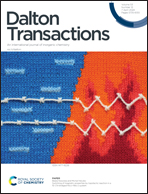Programming heterometallic 4f–4f′ helicates under thermodynamic control: the circle is complete†
Abstract
Three non-symmetrical segmental ligand strands L4 can be wrapped around a linear sequence of one Zn2+ and two trivalent lanthanide cations Ln3+ to give quantitatively directional [ZnLn2(L4)3]8+ triple-stranded helicates in the solid state and in solution. NMR speciations in CD3CN show negligible decomplexation at a millimolar concentration and the latter helicate can be thus safely considered as a preorganized C3-symmetrical HHH-[(L43Zn)(LnA)(2−n)(LnB)n]8+ platform in which the thermodynamic properties of (i) lanthanide permutation between the central N9 and the terminal N6O3 binding sites and (ii) exchange processes between homo- and heterolanthanide helicates are easy to access (Ln = La, Eu, Lu). Deviations from statistical distributions could be programmed by exploiting specific site recognition and intermetallic pair interactions. Considering the challenging La3+ : Eu3+ ionic pair, for which the sizes of the two cations differ by only 8%, a remarkable excess (70%) of the heterolanthanide is produced, together with a preference for the formation of the isomer where the largest lanthanum cation lies in the central N9 site ([(La)(Eu)] : [(Eu)(La)] = 9 : 1). This rare design and its rational programming pave the way for the preparation of directional light-converters and/or molecular Q-bits at the (supra)molecular level.



 Please wait while we load your content...
Please wait while we load your content...